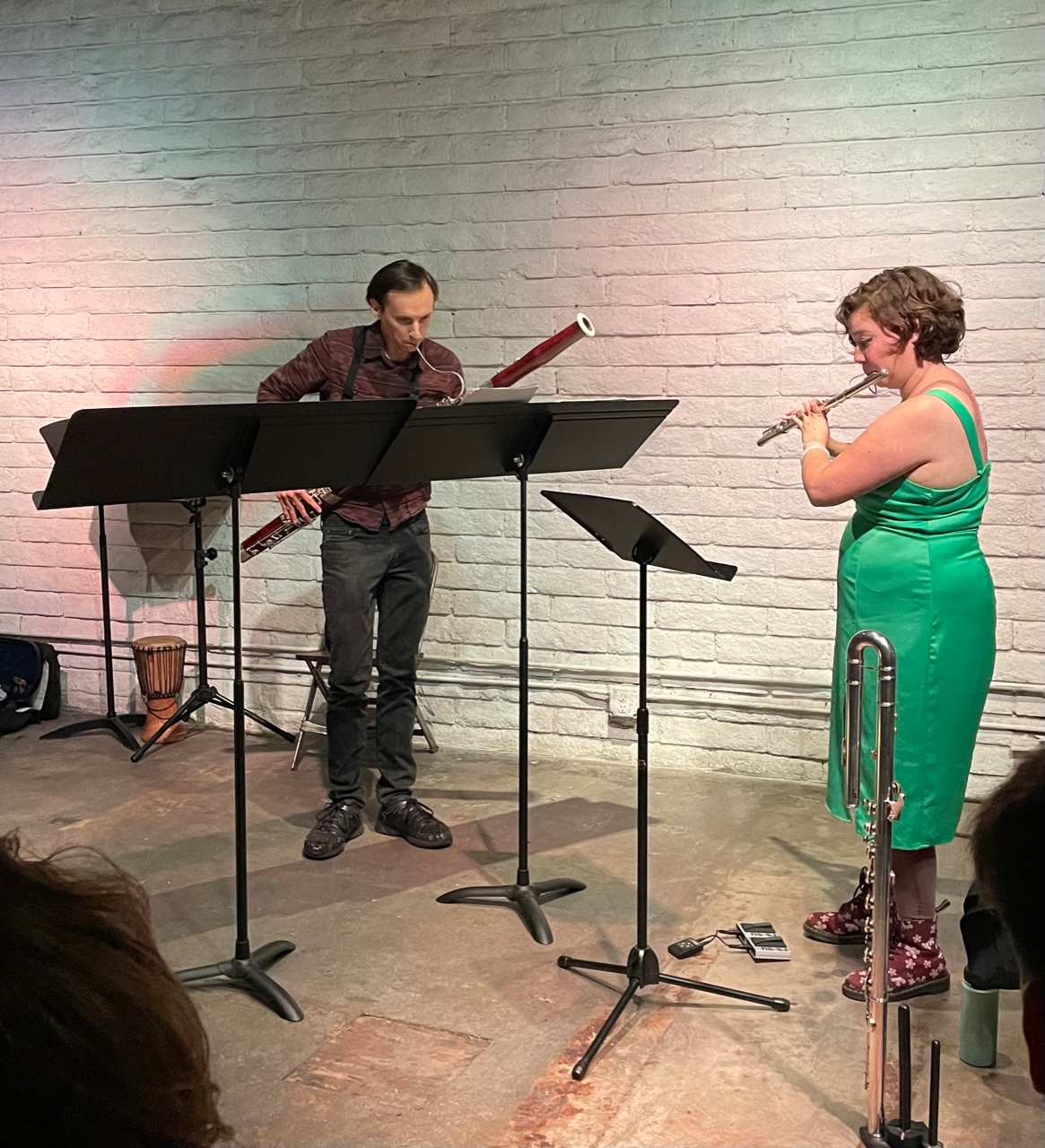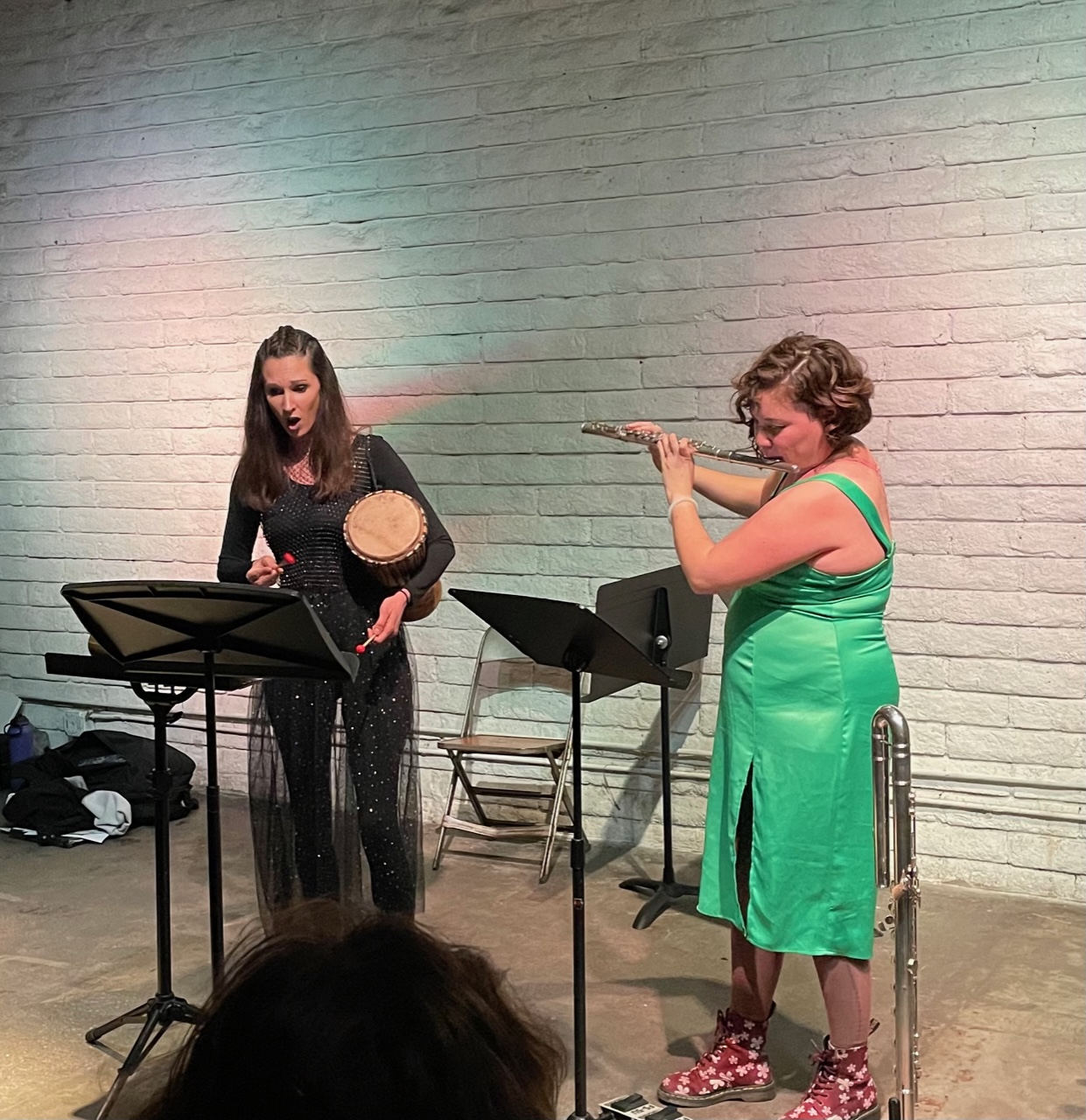Coaxial Arts – Earthly and Unearthly Sounds

On Friday, May 5, 2023, Coaxial Arts in downtown Los Angeles presented Earthly and Unearthly Sounds, a concert of six contemporary pieces that explored the concepts of death, environmentalism, occultism, and feminism. Flutist Élise Roy along with bassoonists Jonathan Stehney, Lauren Martin and Julie Feves were on hand to perform works by Kurt Isaacson, Élise Roy, Sofia Gubaidulina, Mason Moy and Erik Ulman. The concert also included the premiere of a new flute piece by Élise Roy and the world performance premiere of Myrkriða (Rider of Darkness) by Jeffrey Holmes, featuring soprano Kirsten Ashley Wiest.
The first piece on the concert program was Carnal Species, by Kurt Isaacson. This was duet for bassoon and flute, featuring Élise Roy and Jonathan Stehney. This was broadly about birds and the animal experimentation that occurred during the Cold War. Carnal Species began with breathy air sounds and soft notes in the flute. The bassoon joined in with a low fluttery growl that added to an atmospheric feel. Soft sustained notes from the flute contrasted with a number of percussive thumps of air heard in the bassoon. A stretch of long notes from both instruments produced a series of intriguing chords, but this was suddenly cut short by a brief silence silence.
The sustained tones started up again. Honking sounds in the bassoon soon emerged, dominating the texture and evoking vivid images of large birds. This became louder, signaling a distress that was urgently palpable. The piece drew to a close in a flurry of ominous dissonance. Carnal Species is skillfully composed and expertly performed using extended techniques to convey both the pastoral and the sinister.
Duo Sonata for Two Bassoons, by Russian composer Sofia Gubaidulina, followed. According to her publisher’s website “Sofia Gubaidulina is, together with Schnittke and Denisov, one of three major Moscow composers of the post-Shostakovich era.” She was born in 1931 and grew up in Soviet Russia, studying at the Kazan and Moscow Conservatories. Duo Sonata for Two Bassoons is a complicated work and considered a formidable technical test for bassoonists, employing extended techniques, quarter tones and complex rhythmic structures. For this concert, Jonathan Stehney was joined by Julie Feves of the Long Beach Symphony.
The opening of Duo Sonata featured fast runs of descending notes ending in trills. This evolved into a sort of growling match between the two players. The gruff sounds were soon replaced by sustained tones with a distinctly medieval feeling, as if rooted in fragments of a chant. Plaintive crying and sad sounds followed that slowly built into sense of anguish. A rapid series of sharp phrases broke out, conversational, or perhaps more accurately, an argumentative dialogue between the two bassoons. Stehney and Feves were equal to the task with impressive dexterity and precise control. As the piece moved towards its conclusion, the intensity and dynamics of the conversation increased with more loud honking and growling sounds dominating. A low trill completed the piece. Duo Sonata for Two Bassoons is an impressively abstract piece and a showcase for the virtuosity of bassoonists Stehney and Feves.
Next was Eigenvector by Mason Moy, and this was a clever composition employing both graphical and notated scores for two bassoons. The graphical score consisted of a matrix of boxes shown in rows and columns. The top row and the left side column of boxes contained single notated whole notes for the two bassoons, each with a different pitch. One player followed the top row, and the second, the left side column of pitches. The starting player would choose a note from the top row, and the second player a note from any box in the left side column. This produced a distinctive two-note chord that was held for several seconds. Each player then had to identify the note sounded by the other and this yielded two coordinates that corresponded to a box somewhere in the center of the matrix. The players were then directed to separate notated score fragments referred by that box, which were played together for a about minute. The boxes could also direct the players to improvise or to simply remain silent. This process of selecting the sequence of notated segments to be played was repeated for the duration of the piece. The advantage was that the notes and sounds were based only on the choices the players made in the moment. Additionally, each performance of the piece would be unique. Although it seems complicated when described, this system of graphical and notated parts was actually very straightforward in execution.
So what does all this sound like? The initial tones were often very close in pitch and often produced a discernible zero-beating or strong dissonance. Once the players were reading their notated parts, a variety of different feelings were possible: open and grand, sad, dissonant and tense, disorganized or nicely sustained and consonant. All of these feelings were realized as the piece proceeded. Bassoonists Jonathan Stehney and Lauren Martin never lost their way and their playing was excellent. Eigenvector manages to extract a lot of music from some very basic concepts and is further proof that the best experimental ideas often do not require a lot of technology.
To new forest, by Erik Ulman followed, performed by Élise Roy on bass flute. This piece was inspired by the poetry of Ezra Pound and contemplated the quivering of hearts and souls, as well as death and life. The opening included loud notes and fluttering tones in a series of complex passages that recalled images of an anxious heart or a seeking soul. There were often no sustained tones or anything resembling a melody, and this called for a combination of agility and confidence in the playing by Ms. Roy. As the piece proceeded, solemn tones prevailed with a mournful softness. Towards the conclusion, the rhythms became searching and restless as if portraying lost soul. Too new forest ended with a quiet finish.
Next was premiere of the old young woman, by Élise Roy, a dramatic new flute and bassoon piece based on the poetry of Diane di Prima. Johnathan Stehney and the composer were the performers, accompanied by a recorded soundtrack. Whooshing, breathy air sounds from the instruments began the piece and were soon accompanied by thunder and storm sounds from the stage speakers. Trills in the bassoon added to the image of a powerful whirlwind heard coming through the speakers, with the dynamics and intensity steadily increasing to truly frightening proportions. A great commotion was heard from the speakers along with many loud phrases coming out of the instruments. As the piece continued, there were also shouts and screams of a woman and a roaring like that of some giant beast. These sounds washed over the audience in the small Coaxial space with a hurricane-like force. The rushing of the wind and a blizzard of bassoon and flute notes added to the chaos as the piece concluded. The old young woman is a compelling and memorable sonic experience; one that is felt as much as heard.
The final work on the concert program was Myrkriða or Rider of Darkness, by Jeffrey Holmes. Written in 2016, this was the world performance premiere, the piece having been previously released on CD in the 2020 pandemic year. Flutist Élise Roy and soprano Kirsten Ashley Wiest were the performers. Jeffrey Holmes gave a preliminary reading in English of the poetic texts, originally written in Old Norse by the composer. For this concert, there were a series of six short movements that followed the arc of the primal texts describing the moments between life and death. 
Myrkriða opens with sustained notes and a quiet chanting in the soprano, accompanied by soft flute tones that set an appropriately solemn mood. A sharp, almost piercing shout begins in the voice, rising above and ultimately overwhelming the flute. Powerful singing by Ms. Wiest and the close acoustic of the Coaxial space combined to produce impressive vocal statements. As the piece proceeded, the tension rose as the Rider of Darkness brought the dread of death closer, and this was occasionally relieved by more restrained sounds representing the promise of an afterlife. This primal music was well-matched the pagan context. The vocal challenges in this piece are formidable and included equal-tempered and just-intonation microtunings as well as great leaps in the dynamics and pitches. All of this was negotiated with a seemingly effortless ease by Ms. Wiest and also Ms. Roy, who accompanied with commensurate skill. Hopefully this initial live sampling of six movements will lead to a full performance of Jeffrey Holmes’ Old Norse masterwork.
This Coaxial concert marks a welcome return of new and challenging live performances after so many months of enforced pandemic isolation. Earthly and Unearthly Sounds was an unflinching look at the many images of life, death, the occult and the malevolent as expressed in unremitting abstract and complex contemporary music.